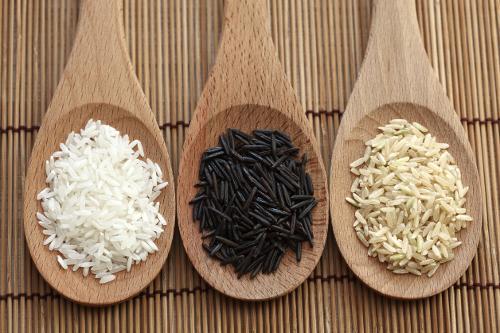
TRANGNHÀ VNY2K
 TRANGCHỦ TRANGCHỦ  Ghidanh
Ghidanh  Ðăngnhập
Ðăngnhập  Danhsách thànhviên
Danhsách thànhviên |
 Xem thưriêng
Xem thưriêng  Banquảntrị
Banquảntrị  Tìmkiếm
Tìmkiếm  Thắcmắc chung
Thắcmắc chung |

TRANGNHÀ VNY2K |
|
| Arsenic in Rice: 11 Facts You Need to Know | |||
| |||
| Tácgiả |
| ||||||||||||||||
|
Arsenic in Rice: 11 Facts You Need to Know
Molly Shea  Rinsing and draining your rice before eating it will remove about 30 percent of the arsenic on it. (Photo by Getty Images) We first heard the bad news in 2012. Rice contains arsenic, Consumer Reports proclaimed in a riveting 2012 study. But it left us with a host of questions: Which types of rice have the highest levels of arsenic? Which have the lowest? What about other rice products, such as rice milk and cereals? And what about other grains? In an update (and video, above) in the January 2015 issue of the magazine, Consumer Reports gives us the answers to each of these questions, and much more—including the recommendation that babies eat no more than one serving of infant rice cereal per day. Here’s what you need to know: 1. Almost all of the different types of rice tested contained measurable levels of arsenic, though levels varied depending on the type of rice. 2. Brown rice has more arsenic than white rice. Consumer Reports found that “80 percent more inorganic arsenic on average than white rice of the same type,” because “Arsenic accumulates in the grain’s outer layers, which are removed to make white rice.” 3. The level of arsenic in rice varies greatly depending on where the rice is grown. White basmati rice from California, India, and Pakistan, and sushi rice from the United States have much lower arsenic levels than other types, and brown basmati rice from California, India, and Pakistan has about one third less arsenic than brown rice from other areas. 4. Rice has higher arsenic levels than other grains because of the way the rice plant grows, since it absorbs more water than other plants. Arsenic is released into the environment through fertilizers and pesticides, which are then absorbed as the plants grow. 5. Watch out for all forms of rice, including rice milk, puffed rice snacks, and gluten free flours and products. The report ”found that rice cereal and rice pasta can have much more inorganic arsenic—a carcinogen—than our 2012 data showed.” 6. Arsenic consumption has been linked to a variety of health issues. As the report states, “Regular exposure to small amounts of arsenic can increase the risk of bladder, lung, and skin cancer, as well as heart disease and type 2 diabetes. Recent studies also suggest that arsenic exposure in utero may have effects on the baby’s immune system.” 7. Consumer Reports recommends reducing rice consumption. Kristin Kirkpatrick, MS, RD, and manager of wellness nutrition services at the Cleveland Clinic Wellness Institute, agrees, telling Yahoo Health, “Arsenic has been found to be a toxic and carcinogenic substance. Of course the amount matters, but until we have more research, limiting rice intake may be an easy thing to do for the majority of the population.” 8. Children are at a greater risk than adults. Arsenic takes a greater toll on their smaller bodies, and kids are more likely to eat rice snacks and drink rice milk than adults. Consumer Reports recommends that “babies eat no more than one serving of infant rice cereal per day, on average, and that their diets should include cereals made from other grains.” Related: Potential Super-Antioxidant in Coffee May Protect Against Obesity 9. Don’t rely on an “organic” label—rice grown organically was found to have the same arsenic levels as “conventionally” grown rice. While organic rice may contain fewer pesticides, arsenic levels are still high. 10. You can cut your exposure by thoroughly rinsing rice before you cook it, and draining excess water after it’s cooked. Consumer Reports recommends a 6-to-1 water-to-rice ratio, rather than the standard 2-to-1 ratio. Yes, rinsing and draining rice might wash away some vitamins and minerals, but the rinse-and-drain technique will remove about 30 percent of the arsenic. 11. Don’t want to risk it? Reach for alternative grains like amaranth, buckwheat, or millet—all contain negligible amounts of arsenic, as do bulgur, barley, faro, and most types of quinoa. Kirkpatrick sees this as “an opportunity to discover the vast world of other grains that provide wonderful health benefits. While rice, pasta and bread have always dominated our dinner tables, this report may lead individuals to try out other grains that were not found to have high levels.” Source: https://www.yahoo.com/health/we-first-heard-the-bad-news-in-2012-rice-contains-103047447432.html ----------------------------- | ||||||||||||||||
 Nov.19.2014 20:07 pm Nov.19.2014 20:07 pm
|
| ||||||||||||||||
| Ðềtài nầy đãcó 0 bàitrảlời kểtừ Nov.19.2014. | |||||||||||||||||
|
| |  Xếp đềtài nầy vào mục cần theodõi Xếp đềtài nầy vào mục cần theodõi  Email cho ngườiquen Email cho ngườiquen  In đềtài nầy ra giấy In đềtài nầy ra giấy
|
|